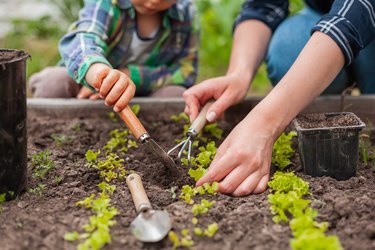
Treflan is an herbicide manufactured by Dow that prevents the growth of grassy weeds and some broadleaf weeds in commercial vegetable growing operations. Some gardeners also use it for weed control. Gardeners who choose to use chemical weed control should observe all of the safety warnings on the product label and use Treflan only as directed.
About Treflan Herbicide
Video of the Day
Treflan is one of several brand names for the chemical herbicide trufluralin. When used properly, it is an effective product for home vegetable gardeners to use for weed control. Treflan vegetable garden weed killer is incorporated into the garden soil as long as four weeks prior to planting vegetables.
Video of the Day
It works by killing grassy weeds and some broadleaf weeds when their seeds start to germinate. Treflan will not kill weeds that are already standing prior to its application.
Treflan Safety Considerations
Treflan is a poison and must be handled with extreme care according to its label instructions. Treflan is toxic to fish and other aquatic organisms, as well as to grassy weeds and plants. It contains compounds that are known to be hazardous to human health. Contact with Treflan can cause skin and eye irritation.
Medical attention is necessary if a person swallows Treflan. Vomiting should not be induced, since aspirating the chemical into the lungs can result in serious medical complications. Limited exposure to Treflan vapors should not be harmful, but the chemical should be used only in well-ventilated areas.
Weed Control Alternatives
A home gardener has many choices about how to control weeds. Chemical herbicides such as Treflan are effective, but they may not be the safest and most environmentally friendly choice. Other weed-control methods can be just as effective, especially in small gardens. Mulching with bark, wood chips, plastic, newspapers or other materials around garden vegetable plants can prevent the growth of weeds. Weeding by hand is an effective way to eliminate weeds, and is also good exercise.
Treflan Application Instructions
Treflan is available at many home garden centers and hardware stores. You can purchase Treflan herbicide granules or opt for the liquid form of the herbicide. The instructions for application of each form of Treflon must be followed carefully to ensure that the proper concentration of the chemical is incorporated into the garden soil. Treflan should be mixed into the top 2 to 3 inches of soil, either by mechanical tilling or by irrigating with sufficient water to carry the herbicide into the soil.
Vegetables Compatible with Treflan
A home gardener should use Treflan to treat only the types of vegetables that are compatible with its use. Treflan is effective for weed control in cabbage (Brassica oleracea), beans (Phaseolus vulgaris), broccoli (Brassica oleracea var. botrytis), peas (Pisum sativum), kale (Brassica oleracea var. acephala), peanuts (Arachis hypogaea), transplanted tomatoes (Lycopersicon esculentum), transplanted peppers (Capsicum annuum) and other plants specified on the product label.
Since Treflan kills grasses, it should not be applied to soil intended for growing corn (Zea mays) or other grass-related crops. Effective application of the herbicide is made easier by planting Treflan-compatible vegetables in one sector of the garden and grassy plants that would be harmed by Treflan in another sector of the garden.